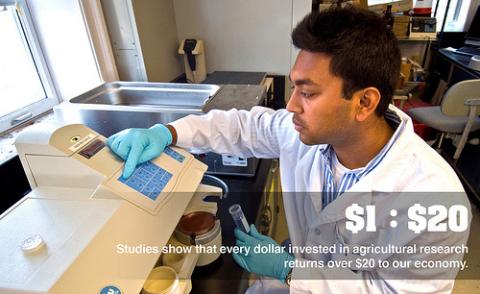Why is the U.S. Department of Agriculture involved with developing an anti-cancer drug? It’s all part of our work to conduct “Made in America” research that produces new technology and creates business opportunities and jobs.
USDA recently issued its annual Technology Transfer Report (PDF, 5.9 MB), which lists research accomplishments over the previous year. In 2016, according to the report, innovative efforts at agencies like our Agricultural Research Service (ARS), the National Institute for Food and Agriculture (NIFA), and the U.S. Forest Service (FS) generated 244 new inventions and 109 patent applications.
While many of these innovations have an obvious link to the agriculture sector, some of them have a scope that might surprise people. For example, researchers from Penn State patented an anti-cancer drug developed from Omega-3 fatty acid derivatives, with financial support from NIFA. While the innovation was related to health care, it was relevant to USDA because Omega-3 comes from agricultural and aquaculture products. Research like this helps us expand our markets while also helping to save lives.
Similarly, the report shows that the FS patented a method to help avoid bridge collapses by providing real-time monitoring of the effects of streambed erosion around bridge piers. This may seem to some like a stretch for an agency that oversees the expansive National Forest system, but those forests have bridges located at sites across the country – some in remote areas that cannot be checked manually as frequently as others. At the same time, USDA is very much involved in promoting rural development, including the maintenance of a rural infrastructure that is showing signs of wear and tear.
There was also plenty of innovative research that more directly addressed traditional agriculture-related concerns. For example, ARS scientists in Florida have demonstrated an effective process for controlling disease-carrying mosquitoes by “silencing” proteins in their genetic make-up. And ARS researchers in Maryland have developed a handheld fluorescent device that more easily detects contamination in meat and food equipment – a tool which will help improve food safety.
These innovations come about in a number of ways: through in-house research at USDA agencies; through USDA-funded research at land-grant universities around the country; and through collaborative relationships with businesses in the private sector. We share and license our discoveries with private-sector partners who turn them into commercial opportunities and, ultimately, jobs.
Studies show that every $1 invested in USDA research generates a $20 return to the U.S. economy. The research we do is a good investment for the American farmer, for the American businessman, for the American worker, and for the American consumer.

